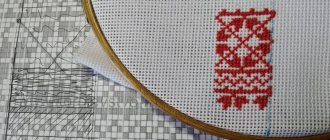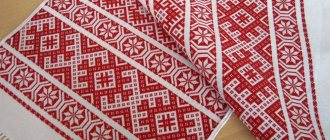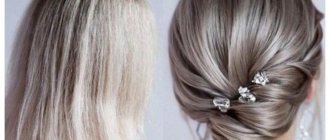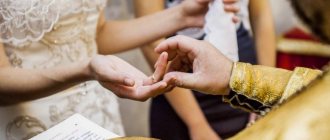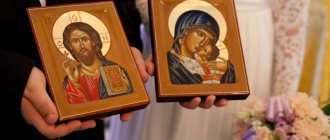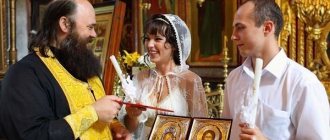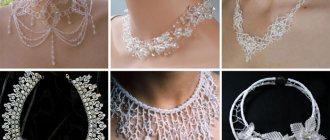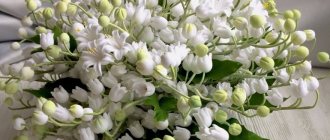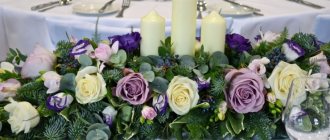A wedding towel is a fabric cloth decorated with patterns on which newlyweds stand at a wedding in an Orthodox church or a wedding in a registry office. Those who want to follow the tradition are wondering where to get a towel for a wedding.
Of course, you can buy ready-made wedding attributes. Towels are sold in specialized stores, various online platforms, as well as in church shops. In addition, you can order a towel from some needlewoman. However, it is much more interesting to embroider with your own hands - this is exactly what brides in Rus' have done since time immemorial. We'll tell you how to embroider a wedding towel and what rules must be followed.
Embroidered towels photo
A towel is a canvas (linen, hemp) that is decorated with embroidery.
The towel was embroidered with a specific ornament, which served as a talisman and protection. Each element of the drawing has its own symbolism and carries a certain semantic meaning.
It has long been believed that an embroidered towel has its own power, can help in various situations and protect. Therefore, earlier embroidered products were not intended for beauty, they performed their specific function.
Beautiful examples
For a loaf of bread, a towel decorated with the inscription “bread and salt” would be an excellent solution. Red and black threads harmonize perfectly with each other, although red is used more. This product is not distinguished by the sophistication of its pattern, but it looks very gentle and cute.
This wedding towel will be an ideal choice for a wedding. Swans, two rings and floral patterns complement each other perfectly. The product looks rich, solemn and stylish.
The wedding towel for the icon differs in size and brightness of the design. Leaves, berries, flowers and birds add richness to the product and represent love and happiness.
To learn how to make a towel-towel, watch the following video.
Embroidery pattern for a wedding towel
The variety of towels during a wedding event indicates the great ethnic role of the towel at every stage: from matchmaking to wedding. In the old days, it was believed that the bride had to embroider towels and outfits with her own hands. Once upon a time, the number of towels used at a wedding ceremony reached 40 pieces.
Today the number of towels has been reduced to 5-6:
- wedding - spreads under the feet of the newlyweds in church, registry office,
- allied towel - their hands are tied,
- “godniks” - two towels are used for icons,
- towel for the Gospel,
- a hospitable towel - a loaf is placed on it.
One of the main ones is the towel, which the newlyweds stand on during the wedding ceremony and painting. According to beliefs, it was believed that it should be long, because its length is a symbol of life together. The towel must be white; this color speaks of sincerity, honesty, and trust. Previously, they even embroidered such a towel with white threads so that life together would be bright.
The drawing should be beautiful, rich, then the couple’s life will be rich and bright. Opinions differ on the issue of the pattern of the towel, which is laid under the feet. Modern copies often contain wedding symbols - wishes, doves, rings. In the old days, it was believed that it was not worth using such symbols, because young people, when they stood on the towel, could trample on the good moments in their lives. Therefore, most often such towels had neutral motifs: floral, geometric patterns.
Embroidery pattern for Easter towel
An Easter towel is a towel, the design on which is supposed to tell about a joyful event - the resurrection of Jesus. It is believed that the main colors for such a towel are black and red, and can be complemented with other shades. The drawing should not be very large. It was once believed that the middle (center) of the Easter towel should be left empty, since this is the place for God.
Krashanki (a symbol of life, rebirth) are considered obligatory elements of the design of Easter towels. Easter cakes (a symbol of fertility) are also often depicted. On modern products you can find other motifs that came from other faiths.
There are no restrictions on the size of the Easter towel, but the canvas must be solid, so it is not advisable to decorate it with hemstitching; you can decorate it with fringe and tassels.
The embroidered pattern on the towel should be neat on both sides. It is believed that the front side is intended for man, and the back side is for God. It is embroidered with a cross, but there can be two versions of the cross: Russian or Bulgarian (more complex).
For children
Talismans or Slavic amulets intended for childhood and infancy are worth studying thoroughly.
The meaning must correspond to what the child needs. Sometimes one photo is enough to help your child gain confidence. And sometimes you have to embroider a Slavic amulet interspersed with several elements. So, for example, in one drawing the elements of Lelya, Lada and Rod are combined.
This occurs when immediate and long-term care is required. Such embroidery amulets are ordered from needlewomen who have been tested by more than one person. The mother will not be able to choose the schemes on her own, but she is able to explain for what purposes the combination is required. Often such a phenomenon as the merging of Old Slavonic protective designs with a cross is required for teenagers for protection.
At this age, dark forces are only trying to take over the bodies and minds of the younger generation. Adolescence is also dangerous because a small child does not have the desire to give up wearing it. But for children 14-15 years old, cross stitch will cause negative emotions and contradictions, as they will be embarrassed to wear it in front of their peers.
Satin stitch embroidery towels patterns
Satin stitch embroidery provides more opportunities for creative freedom. In fact, you can embroider any design; you just need to transfer it to the embroidery fabric. For satin stitch embroidery you need several basic tools and materials:
- needle (must have a sharp end),
- frame (hoop),
- threads (matched to a specific fabric),
- fabric (smooth or counted).
There are several directions for satin stitch embroidery:
- Russian satin stitch - stitches are laid either horizontally or vertically, a gap of approximately two threads is left between the stitches, and on the way back these gaps are filled,
- artistic embroidery - several different colors are used here to make a smooth transition from one tone to another, embroidery technology - bias stitch without flooring,
- satin stitch - laying thin threads that begin in the middle of the next stitch, close to each other, without gaps.
The main technique for embroidery is the oblique stitch. This technique is characterized by the fact that the stitches are laid close to the second element in shape. In this case, the pattern is obtained from the front and back sides. And in order not to forget in which direction and at what angle to place the stitches, you can simply draw guide lines on the fabric.
Another secret: to get convex, voluminous parts, two layers of stitches are used: the first layer may not be too dense, the next layer is placed on top of this ball, where the stitches are already tightly laid.
Bead embroidery pattern for towels
Towels, which are embroidered with beads, are often used as amulet signs. The bead embroidery technique is close in its implementation to the half-cross technique. When embroidering with beads, the peculiarity is that in each stitch a bead is strung on the front side. And on the wrong side you get vertical stitches.
When embroidering with beads, you must remember that in each row the direction of the beads being sewn changes: odd rows start from the left, moving to the right, even rows - from the right to the left.
How to clean the amulet
Any amulet accumulates negative energy over time: it accumulates it without harm to the owner, but weakens over time. Therefore, it is advisable to periodically carry out the cleansing procedure.
You can cleanse the amulet of negativity in different ways: under running water, moonlight and sunlight, over a candle flame. At home, it is better to use regular table salt for this purpose. Just remove the Weddings (be sure to use two people) and leave them overnight in a container with salt. Salt saturated with negative energy should be taken out of the house and thrown away, or at least flushed down the toilet. You can't eat it!
The wedding is an Old Slavonic amulet with powerful energy and deep sacred meaning. But it will help you find happiness and harmony in your family life only if you sincerely believe in its power, honor the traditions of your ancestors and make your own efforts to strengthen the marriage union!
Ukrainian embroidery towels patterns
The Ukrainian towel is a symbol that reflects the history of an entire people.
The key pattern on the Ukrainian wedding towel is the tree of the genus, which grows from a flowerpot or pot. The bottom flowers are a reminder of those family members who have passed away, the middle row of flowers are the families of parents and grandparents. At the top they embroidered buds, flowers that had not yet bloomed - these are future children.
Above the flowerpot and below the flowerpot, no patterns were embroidered. It was believed that the pattern, which is present above the flowerpot, blocks the connection with God. The lower part, which went under the vase, is a symbol of the world of the dead, into which it is better not to meddle.
Another element that is often present on Ukrainian embroidery is the symbol of the Mother. This is an eight-pointed pattern in the form of a star, a flower, a line and a garland of flowers are embroidered around it. Such an embroidered garland signifies recognition of the Mother’s great participation in the life of the clan, her glorification.
Towel for icon embroidery pattern
Bozhniks (towels for icons) have always occupied a special place among other products. Once upon a time, such towels reached a length of about three meters. The icons were framed with embroidered long beautiful towels on major holidays. There were also regular towels, which were used to decorate icons on weekdays.
In the wedding ritual, the presence of two embroidered towels under the icons is necessary - separately for the groom, separately for the bride. It was believed that towels should be different, but they could be united by a pattern that symbolically denoted well-being (grapevine). Each element of the pattern carried its own meaning:
- dove, dove - a symbol of family, peace,
- rooster is a sign of wealth, happiness, strength,
- peacock - family happiness.
Such towels always contained elements that reflected the feminine (viburnum, lily) and masculine (oak leaves, acorns) principles.
The most popular, classic option was cross stitching. Today, such towels can also be embroidered using beads.
Magical meaning
The purpose of the towel depends on its color, embroidery and the nature of the ornament, the location of its individual elements, which in general has a magical meaning:
It was believed that young people could trample on their future happiness. The presence of floral or geometric textures is welcome.
To bless parents for the marriage of their children, patterned towels with unique bright red embroidery are chosen.
Moreover, the so-called god personifying the groom has images of grape vines and oak leaves, and for the bride, bunches of viburnum and lush roses are woven on the canvas.
The names of the newlyweds with wishes, as well as swans symbolizing fidelity and happiness, wedding rings are decorated with towels for tying the hands of the bride and groom in the registry office or church.
Here it is allowed to use any colors of threads, but the predominant color should be red, denoting love, beauty and fullness of life.
This type of canvas is characterized by the absence of restrictions, since it can be decorated with any textures, ornaments and patterns, for example, flowers, leaves, trees, wedding rings, wishes to the newlyweds or images of animals and birds.
Thus, among the most popular symbols depicted on the towel are roses, denoting rebirth, eternity and the sun, doves, associated with peace and happiness, lilies, which are a sign of virgin beauty, innocence and purity, bunches of grapes, carrying a charge of wealth, family well-being and fertility , large families.
Tree images personify the connection between generations and clans, peacocks - renewal, development and progress, viburnum - female beauty and immortality, and the rooster symbolized health, hard work and prosperity.
Embroidery patterns for towels under feet
It is believed that the towel, which is laid under the feet of the bride and groom, is the main one, because it is on it that the couple’s journey is captured. Initially, people did not stand on such a towel, but young people knelt down. Initially, such products depicted a vine, grapes that were supposed to bring prosperity and prosperity to the new family. On one end of the towel—the male side—oak leaves and acorns were embroidered, which symbolically reflect male strength.
On the female side, viburnum was often present - a sign of female beauty, procreation.
The wedding towel was embroidered with one needle, it was not changed. And if the needle becomes dull or lost, then it is better to put such a towel aside.
It is advisable to create a pattern for a wedding towel yourself. You should not completely repeat someone else’s drawing, because in the old days it was believed that in this way a person borrows someone else’s destiny. That is why it is better to complement any pattern with your own touches. An exception may be the pattern of the parent's towel; it can be repeated if the parents had a happy fate.
Video on the topic
Everything you need to know about wedding towels in the video from the Love-Carrot Wedding Events Studio:
By thinking through such wedding details as a towel and a loaf, you pay tribute to traditions and demonstrate to the older generation that this has meaning and special meaning for you.
You don’t have to embroider a towel for a loaf yourself; it’s easier to buy it at a wedding salon.
You will need a set of several towels if you are planning both a wedding and a meeting with your parents. It is better to order a set in one style (the accessories do not have to be embroidered; the products can have typographic designs).
Embroidery of Slavic towels patterns
The process of creating towels is creativity, magic. When creating embroidered work, craftswomen not only put into it skill, energy, charge, but also their soul and love. Therefore, an embroidered towel is not just a beautiful thing that pleases the eye, but also an object that can become a talisman for a person, helping him to recharge himself with positive strength.
Since ancient times, Slavic culture has distinguished several types of towels, each of which performed its own function:
- Handbrake - it was used to wipe the face and hands. These products were embroidered in a special way, the main patterns were swastikas, and later rhombuses. At the same time, when the lower edge was embroidered, wide stripes were embroidered first, then narrow ones, and the upper edge, on the contrary, was embroidered from narrow to wide stripes. This pattern meant the rising and setting of the sun, which is why they wiped themselves with such a towel according to a special ritual: in the morning they wiped their face with the lower end, and in the evenings with the upper end. They believed that in the morning a person received strength, and in the evening he relieved fatigue with a towel.
- A fly is a small towel-shawl. Often embroidered with white thread. This type of towel was used by the bride to wipe away her tears; it was tied on the bride’s hand when she was taken away from her parents’ house.
- Bozhniks are towels that were used to decorate icons.
- Maternity - a towel in which a child was received at birth.
- Podorozhny is a towel that was given to people leaving their home. A simple but thoughtful pattern was embroidered on them, the symbolic meaning of which was the wish for an easy journey, a successful return home.
- An ordinary one - a towel, which was embroidered over the course of one day. It was believed that such products had protective functions, because they were made during the day, when bad forces had no power. Such towels were created only when necessary; they were not embroidered in advance, so they were used only for a specific purpose (cattle were driven through such a towel to avoid diseases, a road was laid out for rain during drought).
- Wedding - there were several types of such towels, each of them performed its own task.
- Funeral - they accompanied a person on his last journey, they were hanged on graves. They embroidered modestly, just a narrow strip along the edge, often with white thread.
History of the Wedding amulet
Here is one of the pagan symbols of our distant ancestors. It appeared in time immemorial, when Christianity had not yet been heard of. The Wedding Charm has been given to young people for many millennia. Most likely, this tradition dates back to the Bronze Age, or even to the end of the Stone Age.
With the advent of Christianity, many pre-Slavic traditions were gradually forgotten. However, at all times there have been adherents of the ancestral culture. In some remote villages, old-timers still remember and honor the ancient gods, albeit at the level of folklore, in parallel with Christianity. It is thanks to them and Slavophile enthusiasts that we now know the history and meaning of most Old Slavonic symbols.
Gold pendant “Wedding Party” (go to the SUNLIGHT catalogue)
The wedding dress was given to the newlyweds specifically for their wedding, when they were recognized as spouses in the face of the gods, ancestors and members of the Family. Not in advance, but on a significant day, when the newlyweds became a family and officially went to bed together for the first time.
Our ancestors turned a blind eye to the premarital pranks of young people. Just look at the Kupala night, when guys and girls split up into couples and looked for fern flowers in the forest! As a rule, weddings took place after this - in the fall, after the harvest.
Belarusian towel schemes
One of the distinctive features of Belarusian ornaments is the use of geometric shapes: squares, stars, circles, quadrangles, rhombuses, stripes. Sometimes such patterns smoothly transform into plant motifs. Floral ornaments were mainly depicted: flowers (most often acacia, lotus), leaves, fruits (grapes)
Another distinctive feature of Belarusian towels is the absence of symbols of death. For Belarusians, the pattern on embroidered items acts as a talisman; it must carry a positive charge. Initially, the ornament was embroidered on a white background using red threads. It is believed that only this nationality managed to preserve the type of patterns that existed among the ancient Slavs. White color is a symbol of purity, openness, red is vitality, blood, sun. Much later, black color appeared in ornaments, but it was used little. The main symbols of the Belarusian towel:
- tree of life - a sign of immortality, eternal life,
- Yarilo on horseback is a symbol of the vital forces of nature, fertility,
- A woman of life is a sign of fertility, harvest,
- symbol of ancestors - a pattern that represents a petition, a prayer to God for one’s relatives,
- sun sign,
- symbol of a child - a talisman sign for children,
- the sign of the Mother is a symbol of all living things,
- Beregini's symbol is a sign of family farming, handicrafts,
- a sign of wealth - a symbol of a wish for wealth, prosperity, offspring.
Patterns and their symbolism
The common origins of the Slavic peoples determine the similarity or unity of meanings of traditional embroidery fragments.
The main signs are:
- the sun was depicted in a circle, a circle with a straight or oblique cross, a swastika sign (svarga, kolovrat). The ornament can consist of straight or curved lines, be based on a circle or square, single or double contours. Usually embroidered in red;
- earth - straight horizontal lines. In the meaning of “sown field,” a rhombus was depicted divided into four parts with dots in each part. The same symbol meant a pregnant woman. When combined with other elements of the design, it is embroidered in black, less often in red;
- water - wavy horizontal lines. Can be modified into a horizontal single, double, or multiple zigzag. In combination with rhombuses - irrigated, fertile land. Embroidered in blue or in primary embroidery colors;
- fire - there was a clear distinction between earthly fire (a fire lit by a person) and heavenly fire (lightning, the sign of Perun);
- world tree, tree of life. Similar signs were used to depict the family tree. Individual elements showed family ties, marital status of clan members, their age and other characteristics;
- signs of the gods. On wedding towels, Lada was most often depicted - the goddess of love and family happiness, Makosh - the goddess of fertility, the giver of life, Rozhanits.
Considering the huge number of symbols and traditional ornaments, let’s look at the most commonly found motifs in wedding embroidery:
- birds - two birds turning their heads towards each other mean mutual, shared love;
- flowers, berries, leaves - a sign of wealth, prosperity, wishes for a fruitful marriage. Viburnum berries and grapes, leaves of grapes, oak, roses, and lilies are especially often embroidered;
- signs of fertility and harmony (Makosh, Lada), sun and goodness (Kolovrat);
- family tree. According to tradition, the bride, in the process of preparing her dowry, embroidered her family tree on one end of the wedding towel, leaving the other end empty. After the agreement (engagement), the second end of the towel was also filled - the groom’s family tree was displayed there.
Additionally: What should a towel be like for a wedding?
Patterns for embroidering towels with flowers
On embroidered towels you can often see flowers that have their own symbolic meaning
- Lily - symbolizes feminine fragility, charm and beauty. These flowers are feminine energy, the symbol of which has always been water. Therefore, a few drops of dew were often embroidered above the flowers, which indicated fertilization.
- Poppy is a symbol of protection from evil and memory of the dead.
- The red rose is the flower of the Sun, which signifies life. That is why rose ornaments were often embroidered in stripes that had no beginning or end. Such a wreath signifies the infinity of life, rebirth.
- Hops are a sign of activity, enthusiasm, youthful love, and development. Therefore, patterns with embroidered hops are often classified as youth. Sometimes the hop symbol is embroidered on wedding towels because it represents a young family.
Symbol of love and fidelity - tattoo
Many people get tattoos to confirm their feelings. Sometimes tattoos are made by a couple together, as a sign of their love and loyalty to each other.
For a tattoo you can choose the following symbols of fidelity and love:
- Hearts in all possible interpretations. Very often, lovers get tattoos in the form of hearts with wings, hearts with roses. It is believed that such tattoos bring love and also help maintain reverent and passionate relationships.
- Angels. Sweet angels are always associated with love, tender and warm relationships. It is believed that angels guard unearthly love.
- Lilies, peonies - these flowers are symbols of love and fidelity among many peoples of the world. This also includes chamomile.
- An inverted “8”, the well-known infinity sign. Very often, lovers apply this tattoo on their ring finger, on which it is customary to wear another symbol of love and fidelity - a wedding ring. The tattoo is applied as a sign of fidelity and endless love.
Infinity
- Also a symbol of love and fidelity is the white dove. Quite often, young people get paired tattoos in the form of two doves looking at each other. Tattoos are often made under the heart, on the ribs.
- In addition to pigeons, swans can also be stuffed, because they personify pure and faithful relationships.
Swans
As a sign of fidelity and love for their partner, many people get a tattoo with his name; those who are especially brave get an image of their lover.
Names
The date of their wedding or wedding can also serve as a symbol of love and fidelity for lovers.
Bead embroidery pattern for a wedding towel
One of the attributes of a wedding event is a towel. Using bead embroidery, you can create a unique copy of a towel, which can become your first family heirloom.
Embroidery does not lose its significance; it remains a subject of admiration, pride, beauty, surprise and great creativity.
